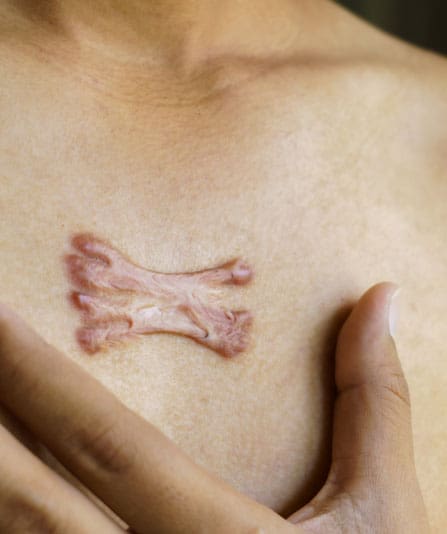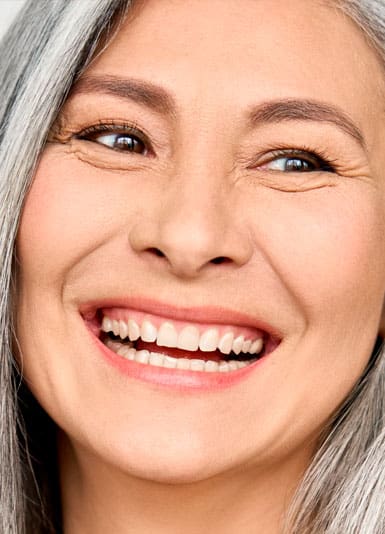Scars by Mr Ioannis Goutos
Keloid Scars

Whenever an area of the skin is subjected to damage through injury, surgery or inflammation, the resultant healing process will normally produce a scar. During this scar-forming process, new tissue is laid down during the ‘proliferative’ phase, including the production of collagen (a type of tough connective tissue). Sometimes when scars are formed, too much of this collagen is produced within the scar and this results in what is known as a ‘hypertrophic’ scar.
These scars appear raised, red or dark in colour and can become painful or itchy. In the extreme spectrum of hypertrophic scars are a group of scars known as keloids. These are formed through excessive collagen deposits within the scar tissue to the extent that it produces an ‘overgrowth’ which extends beyond the original boundary of the injured area. Keloid scars typically appear raised above the skin, and have a shiny and rubbery appearance and texture. They are typically red or appear darker than the original skin tone.
Those with keloid scarring may suffer from pain, itching or low self-esteem due to the appearance of these scars. Whilst difficult to treat, there are a number of treatment options available through experienced specialists that can help to improve these symptoms.
Mr Ioannis Goutos is a leading plastic surgeon with a distinct interest in the care of scars, in particular the management and treatment of keloid scarring. He places particular emphasis on exploring the psychodynamic aspects of scar treatments and the effects that the scarring has on each individual and their quality of life. He has extensive experience in diagnosing and treating keloid scars and is well placed to provide excellent care and cosmetic outcomes for those wishing to have treatment.
Book your consultation today
Book nowAbout this condition
Keloid scars can be diagnosed by an experienced clinician through listening carefully to a patient’s history and performing a detailed examination. A hallmark feature of keloid scars is that they are unpredictable in their formation and growth and can arise any time after an injury (not just in the first few months). Keloids can also become painful, itchy or produce a burning sensation in the skin. In addition, once formed, they may continue to grow at a later time. Occasionally, a specialist may also suggest a biopsy of the scar to rule out a very rare form of skin tumour.
There are number of risk factors and precipitating triggers associated with keloid scarring. Provoking injuries may include:
- Cuts or lacerations to the skin (including accidental injury, surgery or self-harm)
- Piercings and tattoos
- Vaccinations
- Acne or folliculitis (inflammation around the hair follicles)
- Chicken pox or other skin infections
- Burns
Factors associated with an increased risk of keloid scar formation include:
- Having a family history or genetic predisposition to forming bulky or keloid scars
- Having a darker tone of skin
- Injury to an area of skin that is under high tension, such as the chest, shoulders, back and lower abdomen (although keloid scars can arise anywhere on the body)
In addition to the above, there is also an association between hormonal changes within the body and the propensity to develop keloid scarring, for example during pregnancy, puberty or endocrine disorders (such as hypothyroidism). Uncontrolled hypertension (high blood pressure) has also been associated with an increased risk of keloid scar formation.
If you are known to suffer from keloid scarring, there are a number of steps that can be taken to avoid the formation of keloid scars. Firstly, it is important to identify any precipitating factors towards scar development, such as acne or folliculitis. These should be treated early by a skin specialist to minimize the risk of damage to the skin and resultant keloid formation. Further measures that can avoid bulky scar formation include avoiding any preventable skin injuries such as tattoos and piercings. If you have an accident or are planning to have surgery, you should inform your doctor that you are at a higher risk of developing keloid scars. This will allow your doctor to take appropriate measures to reduce the keloidal risk, such as advising additional wound healing treatments or modifying aspects of your surgery.
Treating keloid scars is a very specialist area and should be undertaken by an experienced plastic surgeon and multi-disciplinary team. There are 2 main groups of procedures that can be offered to keloid patients that manage different objectives. The first group of interventions will aim to replace the keloid scar with a fine, symptom-free scar. This is best achieved using extra-lesional (i.e complete) excision of the scar followed by post-operative radiotherapy. The second group of interventions aim to reduce the bulk of the scar and to minimize any pain or itching symptoms. There are a wide range of agents that can be used to achieve this including:
- Steroid injections
- Injection of 5-fluorouracil (a type of chemotherapy medication)
- Application of steroid tapes
- Cryosurgery
- Lasers alone or in combination with steroids
The best treatment for your keloid scar will depend on the location, size and symptoms associated with the scar. Following a detailed assessment of the scar and discussion of your treatment and cosmetic goals, the most appropriate treatment plan can be considered by your specialist team.

Testimonials
Mr Goutos is delighted to share some of his patient and peer feedback on their experiences of his services.











